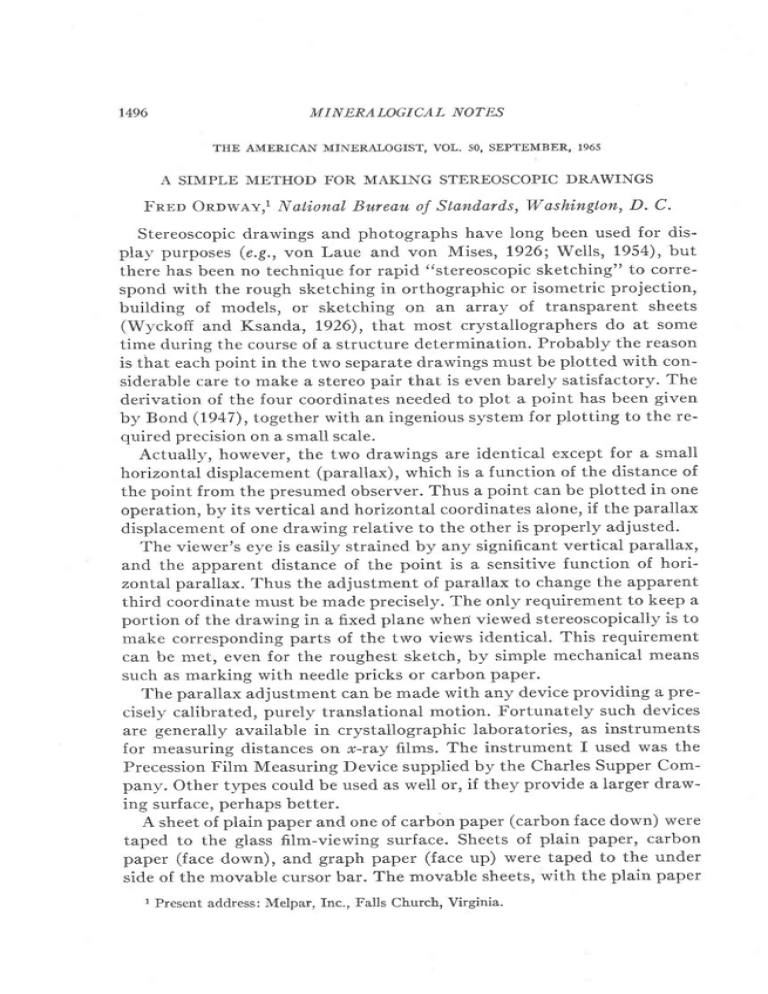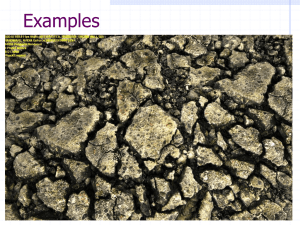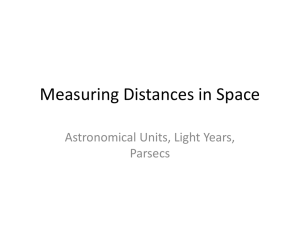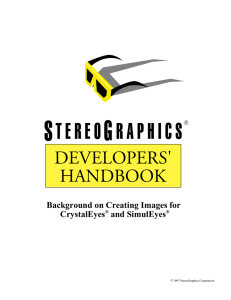the Scanned PDF
advertisement

1496
MINERAINGICAL
THE AMERICAN
MINERAIOGIST,
NOTES
VOL. 50, SEPTEMBER,
1965
DRAWINGS
A SIMPLE METHOD FOR MAKING STEREOSCOPIC
Fnoo Onlwl-u,L I{alional Bureau of Standards, Woshington, D. C.
Stereoscopicdrawings and photographshave long been used for display purposes (e.g.,von Laue and von Mises, 1926; Wells, 1954), but
there has been no techniquefor rapid "stereoscopicsketching" to correspond with the rough sketching in orthographic or isometric projection,
building of models, or sketching on an array of transparent sheets
(Wyckoff and Ksanda, 1926), that most crystallographers do at some
time during the courseof a structure determination. Probably the reason
is that each point in the two separatedrawings must be plotted with considerable care to make a stereo pair that is even barely satisfactory. The
derivation of the four coordinates needed to plot a point has been given
by Bond (1947), together with an ingenious system for plotting to the required precision on a small scale.
Actually, however, the two drawings are identical except for a small
horizontal displacement (parallax), which is a function of the distance of
the point from the presumed observer.Thus a point can be plotted in one
operation, by its vertical and horizontal coordinates alone, if the parallax
displacement of one drawing relative to the other is properly adjusted.
The viewer's eye is easily strained by any significant vertical parallax,
and the apparent distance of the point is a sensitive function of horizontal parallax. Thus the adjustment of parallax to change the apparent
third coordinate must be made precisely. The only requirement to keep a
portion of the drawing in a fixed plane whert viewed stereoscopicallyis to
make corresponding parts of the two views identical. This requirement
can be met, even for the roughest sketch, by simple mechanical means
such as marking with needle pricks or carbon paper.
The parallax adjustment can be made with any device providing a precisely calibrated, purely translational motion. Fortunately such devices
are generally available in crystallographic laboratories, as instruments
for measuring distances orr fi-ray films. The instrument I used was the
PrecessionFilm Measuring Device supplied by the Charles Supper Company. Other types could be used as well or, if they provide a larger drawing surface, perhaps better.
A sheetof plain paper and one of carbon paper (carbon face down) were
taped to the glass film-viewing surface. Sheets of plain paper' carbon
paper (face down), and graph paper (face up) were taped to the under
side of the movable cursor bar. The movable sheets,with the plain paper
1 Present address: Melpar, Inc., Falls Church, Virginia.
MINERALOGICALNOTES
1497
at the bottom, were in contact with the stationary sheetof carbon paper
but moved with the cursor.
Each point was plotted by marking the graph paper accordingto the
first two coordinates after adjusting the cursor to a setting proportional
to the third coordinate. AII points at the same level, and any desired
identifying notes, can be marked at one setting. Different tvpes of atoms
were plotted as circles of different diameters, made with a fine ball-point
pen and a draftsman's circle template. It was not necessaryto avoid
overlapping of marks for different levels so long as the lines were clear.
The two drawingsweremounted together for viewing, a suitableset of
points for alinement having been marked during the plotting procedure.
Frc. 1. A selected center, with its nearest, second, and third neighbors, in a noncrystalline tetrahedral network model (Ordway, 1964). After the centers were plotted, lines
connecting them were drawn on the two views individually. This reproduction is one-half
the original size, for viewing of the entire drawing without a stereoscope.
Interchange of the views inverts the apparent three-dimensional image,
of course;the lower drawing should be viewed by the eye on that side
toward which the cursor moves with increasins distance from the
hypothetical observer.
For direct viewing, which is the most convenient way of using stereo
pairs (Hughes, 1964), the width of the sketch must be kept beiow the
interocular distance of about 6 cm. The proportions of the stereoscopic
image depend upon a suitable choice of scaleconstant for the parallax adjustment. A total parallax range of about 1 cm is ample for drawings to
be viewed at normal reading distance.
Larger sketches may be viewed with the conventional stereoscope,
whose lenseshave prism components to reduce the divergence, or with
1498
MINERALOGICALNOTES
anlr of the various reflectingarrangements.By placing the carbon paper
belorv one sheet of paper and above the other a reversedpair can be
made for viewing with a single mirror.
Sketchesmade by this simpie procedure (Fig. 1) suffer all the deficienciesof orthographicprojectionscomparedto perspectivedrawings,
but proved very helpful in checkingdiscrepancies
in the coordinatedata
for a model network structure ol ll44 atoms. Data for perspectiveprojections, calculatedas describedby Bond (1947),ma1,be plotted equaily
well by this method. If the parallax adjustment is graduatedin terms of
the third coordinagewith a specialscale(which may be non-linearto give
a geometricallvperfect stereopair) the points can be plotted almost as
rapidlf in the three-dimensionalsketch as on an ordinarv map.
Rnrl;. nxces
BoNo, W L. (1947)Am. Mineral. 32,454.
Hucurs, R. D. (1964)GeoTimes
8 (6),25.
Omwev, F. (1964)Sci.ence
143,800.
voN Laun, M. exr R. voN Mrsns (1926)Stereoskopbil,der
ron Kristatrl,gittern.
JuliusSpringer,
Berlin.
Wnr,r,s,A. F. (1954),Acta Crystal,7,545.
Wvcrorr, R. W. G. exo C. J. KsaNra (1926)Am. Jour. Sci. ll, 377-80.
THE AMERICAN
MINERALOGIST,
VOL. 50, SEPTEMBER,
1965
A NEW OCCURRENCE
OF ANDORITE
Sroxoy A. Wrr-r-r,s.r{s,
Sil,aerKing Mines, Inc.
Andorite has been found in silver ores from the Taylor district near
Elir, White Pine County, Nevada. The ores occur in brecciated limestones on either side of a fault zone and consist of sphalerite,galena,
enargite,bournonite,tennantite, andorite and stibnite in varying proportions. Minor amounts of stephanite,miargyrite, and pyrostilpnite also
occur. Gangueminerals arequartz, pyrite, fluorite and rare barite.
Andorite occurs as fine single crystals up to 6 mm in length in a vuggy
silicified limestone. Most crystals are perched upon drusy quartz but
some anhedraup to 12 rnm acrosshave been noted embeddedin quartz.
Measurement of several crystals on the two-circle goniometerrevealed
t h e f o l l o w i n gf o r m s :b , [ 0 1 0 ] ; u , { 1 3 0 } ; k , [ 1 2 0 ] ; 1 , { 2 3 0 } ; m , { 1 1 0 } ;
o , { 3 2 0 } W , { 3 1 0 } ; X , { 0 1 1 1 ; " y{ 0 2 1 1 y; , { 0 3 1 1 ; r ,[ I 2 t ] ; a n d e , 1 3 6 2 1 .
The crvstals are elongateon [001] and somewhat tabular on {100}. All
{ h k O } a r e p r e s e n ta s s t r i a e w i t h t h e e x c e p t i o no f { 2 3 0 } a n d { 1 2 0 } . A
typical crvstal is illustrated in Fig. 1.
Strongerpowder diffraction lines and estimated intensities(on a 1 to



